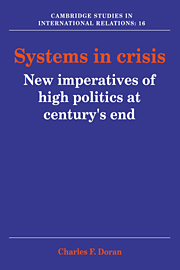Book contents
- Frontmatter
- Contents
- Preface
- Acknowledgments
- Introduction: new perspectives on the causes and management of systems crisis
- Part 1 Dynamics of state power and role: systems structure
- 1 What is power cycle theory? Introducing the main concepts
- 2 Measuring national capability and power
- 3 The cycle of state power and role
- Part 2 Dynamics of major war and systems transformation
- Part 3 Dynamics of general equilibrium and world order
- Part 4 Systems transformation and world order at century's end
- Appendix: Mathematical relations in the power cycle
- References
- Index
2 - Measuring national capability and power
Published online by Cambridge University Press: 08 September 2009
- Frontmatter
- Contents
- Preface
- Acknowledgments
- Introduction: new perspectives on the causes and management of systems crisis
- Part 1 Dynamics of state power and role: systems structure
- 1 What is power cycle theory? Introducing the main concepts
- 2 Measuring national capability and power
- 3 The cycle of state power and role
- Part 2 Dynamics of major war and systems transformation
- Part 3 Dynamics of general equilibrium and world order
- Part 4 Systems transformation and world order at century's end
- Appendix: Mathematical relations in the power cycle
- References
- Index
Summary
“After 200,” writes historian J. M. Roberts (1983), “there are many signs that Romans were beginning to look back on the past in a new way. Men had always talked of golden ages in the past, indulging in a conventional, literary nostalgia. But the third century brought something new, a sense of conscious decline” (p. 272). What was this Roman perception of conscious decline, and why was it “new”? Why was it that Romans as a polity could perceive that their power was in decline, and that historians, despite the intervention of centuries, can identify a precise interval when this sense of decline dawned on the contemporary Roman? Such contemporaneous perception of power, and of sudden change in the trajectory of power, is what any index of state power worth formulation must capture.
The goal of this chapter is to develop an index, or standard “yardstick” to “measure” a state's political evolution as a major power in the more recent historical past. Such a yardstick for power would have to be broad-based so as to encompass a variety of foreign policy leadership functions, and it would have to counterbalance actualized capabilities with those latent capabilities necessary for the state's continued long-term growth. The indicators chosen would have to be so basic to international political relationships that relative changes in the yardstick would be readily discernable in the operations of statecraft.
- Type
- Chapter
- Information
- Systems in CrisisNew Imperatives of High Politics at Century's End, pp. 44 - 58Publisher: Cambridge University PressPrint publication year: 1991



